Reviews
Metal Gear Solid HD Collection (Vita)
June 27, 2012, Author: Andy Corrigan
Earlier this year, Konami released the Metal Gear Solid HD Collection on PS3 and Xbox 360 to great reception. As a remastered gathering of MGS2, MGS3, and a port of the previously PSP-only Peace Walker, it not only represented great value for fans, adding Achievements and Trophies into the mix, but it was also the perfect chance for newcomers to get in on the fun.
At that time, however, I personally had zero interest in this package. You see, I’ve always had a hate/hate relationship with Metal Gear Solid, despite having played all the games (although MGS3 & 4 only part way through, as it was all I could bear). The thought of delving back into Kojima’s wonkily written but complex world of espionage made me feel a bit queasy.
There was, however, a huge turning point for me recently, when I was the only person available to review Metal Gear Solid 3D: Snake Eater for 3DS. Thankfully, I’m pretty open-minded and went in prepared to give it every opportunity to sway my opinion. Low and behold, this time something clicked. I finally got it. It turns out that given a chance, this game I’d previously called ‘an abortion’… was actually rather good.
I still took issue with some of the game’s Kojima-isms (incessant babbling and gameplay disrupting cut-scenes), but still, the review process had almost been something of a profound personal journey. I was proud that I was willing to test the weight of my own opinion and because of that, I came away with a different, more positive perspective.
As I hinted at the end of that review, it also meant I might just have the inclination to give that Metal Gear Solid HD Collection a chance after all, just to see if I couldn’t be swayed any further. With the collection coming to Vita this very week, sans Peace Walker (already available on PSN, however), I knew I’d never have a better chance to continue this crazy experiment.
We’ve covered both the home console versions of the HD Collection and MGS3D: Snake Eater in great detail in previous reviews, so make sure you check those out too for more detailed and varied opinion.
What a tangled web we weave…
In Metal Gear Solid 2: Sons of Liberty, we find Solid Snake and his unlikely friend, Otacon, now working for themselves under the banner of ‘Philanthropy’, a newly formed agency on the edge of government recognition. Snake heads to New York to infiltrate and investigate a fairly inconspicuous looking oil tanker, following an anonymous tip that the US Marines secretly have a new, amphibious Metal Gear on board.
As he’s about to infiltrate the boat, Russian separatists attack with the aid of Snake’s old nemesis, Revolver Ocelot. Regardless, Snake continues his mission to supply photographic evidence of this new Metal Gear, known as ‘Metal Gear Ray’. Of course, Ocelot, now possessed by the arm of the Shadow Moses mastermind Liquid Snake, destroys the tanker and makes off with the US Marines’ new toy.
Snake is reported dead in the incident; however, two years later a terrorist group calling themselves the ‘Sons of Liberty’ have kidnapped the President and taken control of Big Shell; an oil decontamination facility located off the coast of New York, built to deal with the oil spill left by the tanker’s destruction. Interestingly, though, the Sons of Liberty have named Solid Snake as their leader. It’s here where the infamous twist takes place. Players now take control of rookie agent Raiden for the rest of the game as he tries to rescue the President, determine whether Solid Snake is still alive, and find out why he has gone rogue.
Metal Gear Solid 3: Snake Eater takes the action back to 1964, during the Cold War era. Naked Snake (known later in the chronological story as ‘Big Boss’) is sent to the jungles of Tselinoyarsk to find and recover a kidnapped scientist called Sokolov. During the mission, Snake discovers that his closest friend and mentor, The Boss, has defected to The Cobras; a deadly band of Russian separatists.
Snake is beaten and broken by his former teacher, who helps the leader of The Cobras, Colonel Volgin, steal an experimental tank called the Shagohad. A nuke is set off in the process, and the USA is ultimately blamed. The USSR, however, are willing to give the USA a chance to prove their innocence in a last-ditch attempt to avoid World War 3. Naked Snake is redeployed to Tselinoyarsk to find and kill The Boss, and stop Volgin’s scheme.
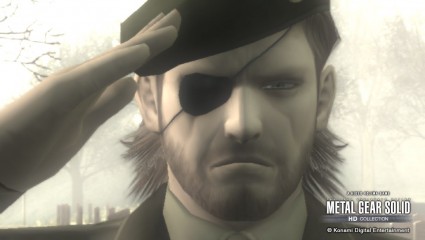
It's a one-eye Snake! Get it?!
Despite my recent turnaround, I still have the same issues with much of Metal Gear Solid’s writing across both games. It’s unnecessarily complex, uses too many twists (both predictable and unpredictably ridiculous), and the pacing is fucking shocking. I can get over the complexity, I can accept that it’s part and parcel of the Metal Gear experience; but I can’t get over it when it has a negative effect on gameplay.
In this sense, both games are guilty of bombarding the player with too much dry information intermittently, especially in the early portions. It makes gameplay feel way too broken up just when the player should be coming to terms with the controls. I make no exaggeration when I say that it’s a case of walking a few steps, getting a lengthy cut-scene, walking a few more, getting an exhausting call with your superior officer. Rinse and repeat for the first few hours.
“Oh cool, an enemy… if I just snea~” BEEP BEEP! “Seriously, again?!”
It’s a frustrating introduction.
Thankfully, both games do admittedly take the reins off and let you get on with playing after the first couple of hours, interrupting you only when necessary and appropriate. It’s in this balance between cut-scene and gameplay where both games really excel.
In MGS3’s case particularly, the story becomes infinitely more interesting as it stops trying to push its conspiracy theories on you and focuses on its real strengths; the characters. There are moments in MGS3 where the writing suddenly becomes phenomenally gripping and engaging, and Kojima’s trademark charm and humour really come to the forefront, and it’s brilliant. As I found with the 3DS version, I warmed to the story the more I played, and it’s simply because of that shift in focus. It’s all about pacing, and that’s its one real failure as a whole.
MGS2 doesn’t cope quite as well in this respect, simply because Raiden, try as he might, is just an abysmal character. His conversations lack the charismatic snap and pop of Snake’s, especially when dealing with his wife who just won’t ever shut up about nothing in particular. The couple’s involvement puts a real dampener on a game that otherwise plays pretty damn well.
The package includes the Substance and Subsistence editions of both games respectively, meaning that it includes all the additional content (VR Missions, additional modes, fresh background etc), but MGS3 comes with an extra treat: it features the MSX versions of both of the original, 8-bit Metal Gear games. I’ll cover their plots briefly, as although they’re simply here for nostalgia, they’re totally worth checking out for hardcore fans of the fiction.
Metal Gear covers Solid Snake’s rookie days as a new member of Foxhound. Supported over the radio by his genetic father, Big Boss (Naked Snake in MGS3), Snake must find out what happened to the previously deployed agent ‘Gray Fox’ in South Africa, and discover what his final communication of ‘Metal Gear…’ meant. In Metal Gear 2: Solid Snake, Snake is deployed by Foxhound’s new commander, Roy Campbell, to rescue Dr Kio Marv from ‘Zanzibar Land’ before his captors can hold the world hostage. For their time, both games are surprisingly story-heavy, and provide an enjoyable insight into beginnings of the Metal Gear series.
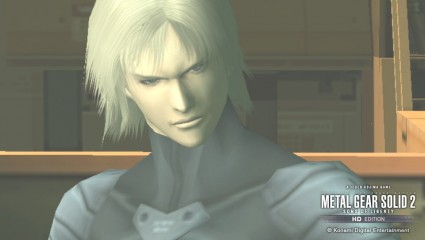
Considered by some to be the worst thing about the Metal Gear Solid series...
Sneakers
It would have been so easy for Konami to have Armature Studio provide a straight port of the standard HD Collection, but time has been taken to add in some smart touchscreen functionality. For example, where weapon and gadget selection were mapped to shoulder buttons that don’t exist on this format, they’re now touchscreen implemented. You simply touch one of the black boxes in the bottom corners and drag your thumb to the item you want to select in one swift move. This is a huge improvement.
Also, in recognising that leaning out of cover could be finicky and problematic in its original state, once backed against a wall you can drag your finger across the touchscreen in the appropriated direction to lean out. This is an optional feature, in case like me, you’d prefer to leave your hands where they’re comfortable. When in a first person view, you can similarly perform the same motion on the back touchpad to sidestep slightly to the left or the right. In MGS3, touching the backpad while taking hold of an enemy will cause Snake to interrogate them. Again, this is a simple change, and it’s one that’s not a pain in the arse to use in the middle of gameplay.
There are a couple of things I will say having played MGS3 recently on 3DS. Firstly, switching back to using the square button to fire a weapon feels like a step backwards. It’s a complaint that’s easy to get over, sure, but I’m left wondering why they didn’t provide some different control options, considering that they took the time to implement some well thought touch control. A minor complaint, though.
The 3DS version also included the ability to walk while crouching, making it easier and quicker to sneak up silently upon unsuspecting victims. Also, I’m left wondering why they didn’t make use of the Vita’s cameras for the custom camouflage feature, as it was a nifty and useful little system on Nintendo’s handheld. Still, these are all minor complaints as fans will get MGS3 in its most purest form, exactly as they remember.
Similar controls aside, Sons of Liberty and Snake Eater are two very different games at a base level. MGS2 follows much of its cues from the original PSOne classic, using predefined camera angles (mostly top-down) and a radar constantly showing a guard’s location and field of vision, allowing you to determine your best possible route with distraction techniques and gadgets to help you get to where you want to be.
There are some niggles with this system. Notably, you have no control over the camera, making it a little difficult to know what’s coming up ahead unless you switch to first-person view or back against a wall. Still, as you get into the habit of standing up before you move and being extra cautious about what’s up ahead of you, you’ll find that MGS2 plays a bloody good game, even if it doesn’t talk it.
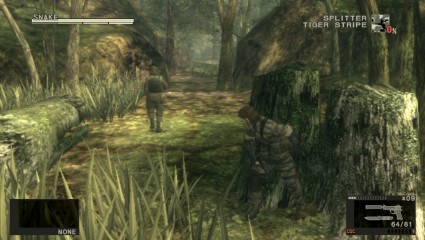
Yeah... he must work out...
In comparison, MGS3 is a much freer, organic and involving experience, and is definitely the highlight of the duo. It switches the perspective to a direct third person view, with a camera that always follows Snake as he works his way through the jungle, offering you true control on the right stick.
That isn’t the only significant improvement, as you’ll need to use the environment to your advantage, instead of just relying on angles to mask your presence the entire way through. Seeing as you’ll be spending most of the game in the great outdoors, the right camouflage is a must, and you must change it every time the environment or surface changes to avoid detection. A percentage indicator, not unlike Splinter Cell’s darkness indicator, will tell you how well hidden you currently are, and if it’s low, that should be your cue to hit the menu and make a change.
Radar is also handled very differently, stripped back a little to fit the era. Here it works like traditional radar, where it sweeps a radius around you periodically for signs of life. You can’t see where an enemy is looking as previously, either, and it runs on a battery, so seldom usage should be considered.
Instead of using rations to heal as per MGS2, Snake’s health will automatically regenerate as long as you keep his stamina in check, and you do this in a couple of ways. The most important way is to keep him fed. If you don’t, not only will he heal slower, but he’ll run slower and his aim will become hard to control. His stomach will also start to make tell-tale noises; not ideal when trying to avoid detection.
Food is obviously a scarce commodity in the jungle, so outside of rations and finding food in enemy locations, you’ll need to take a knife to the local wildlife to keep up a good supply. Don’t let the food linger in your inventory, though, as it will spoil and give Snake a stomach ache when consumed, which also makes an unfortunate, unwanted noise…
The other element in maintaining Snake’s stamina is keeping his injuries and illnesses under control. Should you take a bullet, get bitten by a spider or get burnt, you’ll need to treat it accordingly. So for example, with a gunshot wound, you’ll need to remove the bullet with a knife, and then treat the wound with disinfectant. A broken bone will need bandages and splint, while a dodgy stomach or poison can be treated easily with some medication. It’s all menu-based, so performing these actions is not as exciting as it sounds, but it’s a really cool way to enforce the survival aspect of Snake Eater.
Across both games, the enemy A.I. is exceptionally good when you’re undetected, although in MGS2 it’s a little simpler. Guards walk their set paths ad nauseum, with some other predefined patterns interspersed depending on the scenario (nodding off for a brief second, looking down a rifle scope, etc), and they’ll generally have no need to doubt something unless you give them reason to. In MGS3, guards are a little more unpredictable (they’d have to be with all that wide open space for you to hide in), making sure to check under small spaces and investigating the slightest hint of noise. You certainly feel more hunted in this MGS over its predecessor.
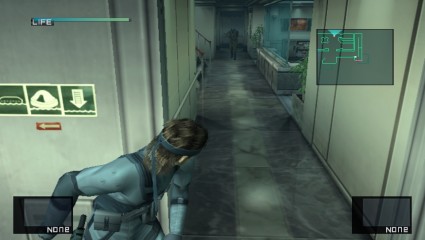
Savour playing as Solid Snake, as you're about to have that privilege ripped away from you...
That’s not to say that there aren’t plenty of nice touches in MGS2, too. There was one memorable point where I had been spotted but managed to get out of sight, taking refuge in a cardboard box in a corner. Five guards ran in, had a look around before four gave up and continued looking elsewhere. The last guard kicked the box twice to test. With it behaving as he expected, he was about to walk off, or so I thought. He then turned back, lifted the box up to find Raiden sat underneath with all the demeanour of a naughty puppy. The chase was back on, and it was both great fun and hilarious.
When you get discovered, however, guards become incredibly dumb; particularly in MGS3. Where they were once organised, they’ll converge on your position in great numbers and almost in single file, but then run around the immediate area erratically, never seeking cover. With less space to comb in MGS2, it’s less noticeable there, but it still looks like a deadly conga line, and in both cases escape looks a messy process.
The boss fights found in either game are formulaic but fun. You’ll rarely ever be in stealth mode when against them, and nearly every time you’ll feel like you’re being pressed really hard. Until, you work out the magic pattern to take them down, that is. Once you understand those attack patterns, you can get most of them down in minutes, but it’s great fun working it out for yourself.
MGS3 in particular has one amazing boss battle against an old sniper called ‘The End’. It’s so good, that after I beat him the first time around, I literally wanted to grab everyone I walked past by their shoulders, and proceed to shake and yell at them excitedly about it. It’s easily one of my favourite boss fights ever, and my stand out moment in the series.
Because I mentioned them previously, I’ll touch briefly on the inclusion of Metal Gear and Metal Gear 2: Solid Snake once more. Metal Gear is as basic and old school as they come. Played from a top down view, guards can only see in straight lines directly in front, and Snake has no real abilities other than walking, shooting and using items. The basic idea is still to keep out of sight, though. The sequel will be of much more interest to fans, as Snake can use a lot of his modern repertoire, crawling through vents and hiding in small spaces, while guards can not only see within a cone of vision, but can also turn their heads. There’s an amazing amount of innovation to be seen from the 8-bit era.
A very nice touch for people who already own the PS3 version of the HD Collection, is that you can freely transfer your game save between the two systems and pick up exactly where you left off. Taking this a step further, if you unlock Trophies on one version, you’ll also unlock them the next time you boot up the other. While buying the HD Collection for one system doesn’t automatically give you a free copy for the other, this is definitely a pleasing inclusion. Unfortunately with my PS3 still in the UK, it’s something I’ve been unable to test, but it’s there for those who want to use it.
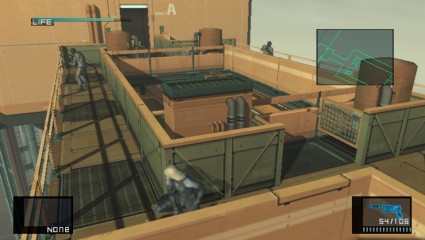
Be very, very quiet...
Shedding skin…
Metal Gear Solid has always impressed visually, nearly always pushing the boundaries of its format of choice at first release. To be honest, it doesn’t seem as if there had to be a lot of work required in the transition from standard definition to HD to make either game look gorgeous on the Vita’s OLED screen. Both games look bright and crisp, and it’s surprisingly rich in detail for a ten and seven-year old game respectively.
If you could level any complaint, it’s that in Metal Gear’s traditional fashion, textures and models can look a little flat. It’s well within the boundaries of its usual visual style, though, and that does actually help it look less dated than it otherwise might have. It also helps that the original visual design was absolutely top-notch on nearly every level, with amazing attention to detail.
With that, there are some sweet ass touches too. For example, in the early tanker chapter of MGS2, when Snake dies it retains the same design as it did in the PSOne’s original Metal Gear Solid, complete with the same music. However, with Raiden being a different character, his death sequence is more grey and clinical. Whenever there are flashbacks to Shadow Moses it simply uses old PSOne footage, which sounds really shoddy, but it’s a lovely nod to what came before, and it’s utterly charming.
Sorry David, I’m a ‘Hayter’
Like I said in the MGS3D review, I’m still not hugely enamoured with David Hayter as Solid Snake in spite of his cult status, but I do at least appreciate why he’s a popular choice with fans. While a lot of the dialogue in both games is long-winded nonsense, it’s at least well brought together, and the voice actors seem to revel in their cheesy B-movie delivery. Josh Keaton as a young Ocelot in MGS3 is still a particular favourite of mine, while Neil Ross is awesome as Volgin. Paul Eiding as Colonel Campbell is the highlight of MGS2, as Raiden’s immediate superior.
Both games have awesome, blockbuster quality soundtracks that are instantly recognisable. I hadn’t played MGS2 since it first released in 2001 and have only played it the once, yet a warm rush of nostalgia hit me the instant the menu booted up. Always a sign of a quality score.
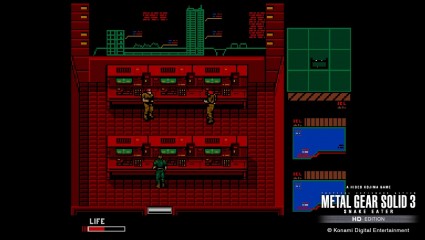
The original two Metal Gear games are a nice bonus.
Snake’s revenge?
You know what? Despite the same old issues nagging at me, I have to admit that I had a lot of fun with both titles overall, even in sampling MGS3 for the second time within a relatively short period. I accept that my criticisms of both games are elements that the real Metal Gear fans will adore, and for those people, it’s all part of the attraction. Even if you share a similar train of thought to me, however, there’s enough in this package to provide you with many hours of enjoyment. There’s solid gameplay, a great atmosphere and a light-hearted charm and self-awareness that goes a long way in connecting with the player.
MGS2 is the faster-paced, lighter game of the two that, regardless of my dislike of the story, I’ve always thought of fondly solely from a gameplay perspective. I’m pleased to say that it still just about holds up in that regards, and although that’s thanks mostly to its inherent simplicity, it’s still impressive for a ten year old game. MGS3, on the other hand, is easily the deeper and technically superior experience, taking a slower, more thoughtful approach, truly embracing its themes of stealth and survival. A (comparatively) focused plot also helped no end in endearing it to me a little further, with great moments and characters that really come to shine against the earlier poor pacing.
As it stands, even without Peace Walker in the package, the Metal Gear Solid HD Collection is a worthy purchase, representing splendid value for money. Not only do you get two of the industry’s most highly regarded games in their entirety, along with every single piece of additional content that came in their Substance and Subsistence rereleases, but you can play them wherever you like, tweaked and perfectly tailored for Vita.
Platforms: PS Vita | Tagged Hideo Kojima, Metal Gear, Metal Gear Solid, Metal Gear Solid 3 Snake Eater, Metal Gear Solid: Peace Walker, Metal Gear Solid: Sons of Liberty, Naked Snake, Solid Snake



